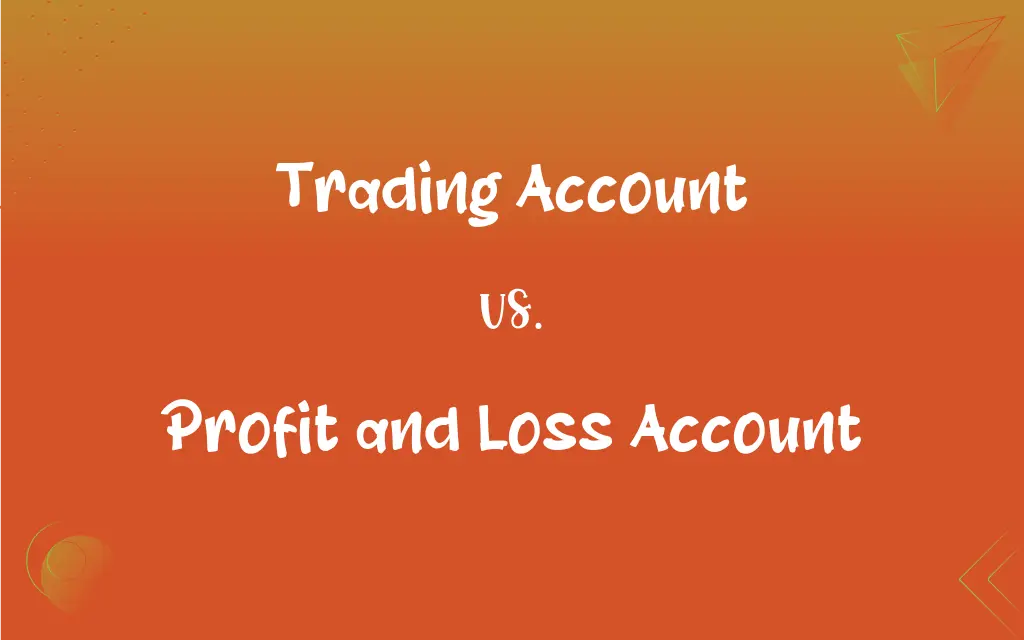Trading Account vs. Profit and Loss Account: What's the Difference?
Edited by Aimie Carlson || By Harlon Moss || Updated on October 25, 2023
A trading account shows the results of buying and selling goods, while a profit and loss account provides a comprehensive view of a company's overall financial performance.

Key Differences
A trading account primarily focuses on the gross profit or loss made from trading activities, essentially representing the direct income and expenses associated with these activities. On the other hand, a profit and loss account, often termed an income statement, covers both direct and indirect incomes and expenses, giving a broader perspective of a company's profitability.
The trading account, at its core, details the cost of goods sold and the sales generated from them. By subtracting the former from the latter, it determines the gross profit or loss. The profit and loss account starts with this gross profit (or loss) and then accounts for all other expenses and incomes, such as administrative costs, financial costs, and other indirect expenses and incomes.
Establishing a trading account is the preliminary step in the final accounting process for trading businesses. It's a foundational component upon which further financial assessments are built. The profit and loss account, conversely, captures a company's entire operational performance, encapsulating not just trading but all activities, making it indispensable for stakeholders to gauge overall financial health.
While the trading account wraps up by presenting the gross profit or loss, which is carried forward to the profit and loss account, the latter culminates in showcasing the net profit or loss. This net figure from the profit and loss account is pivotal for decision-making, understanding business growth, and assessing managerial efficiency.
Although both the trading account and profit and loss account aim to elucidate a business's financial stance, their scopes differ. The trading account narrows its focus on trading activities alone, while the profit and loss account provides a panoramic view of all financial facets, from trading to overheads to financial costs.
ADVERTISEMENT
Comparison Chart
Purpose
Determines gross profit/loss from trading activities
Determines net profit/loss considering all incomes and expenses
Components
Cost of goods sold, sales
Gross profit, indirect expenses, indirect incomes
Outcome
Gross profit or loss
Net profit or loss
Scope
Limited to trading activities
Covers entire operational performance
Position in Final Books
Preliminary step in final accounting for trading businesses
Comprehensive assessment of financial health
ADVERTISEMENT
Trading Account and Profit and Loss Account Definitions
Trading Account
A trading account assesses the gross profit or loss from trading activities.
The trading account showed a favorable gross profit this quarter.
Profit and Loss Account
A profit and loss account gives a holistic view of a company's financial performance.
The profit and loss account revealed an overall net profit despite high indirect expenses.
Trading Account
A trading account is the initial step in the accounting process for traders.
Before diving into other expenses, they analyzed the trading account.
Profit and Loss Account
A profit and loss account starts with gross profit and factors in all other expenses and incomes.
The profit and loss account indicated high administrative costs impacting the bottom line.
Trading Account
A trading account provides a foundation for the profit and loss account.
The gross profit from the trading account was carried forward for further assessment.
Profit and Loss Account
A profit and loss account is also known as an income statement.
Stakeholders examined the profit and loss account to understand the fiscal health of the company.
Trading Account
A trading account excludes indirect expenses and incomes.
The trading account only showcased the direct trading results, not overheads.
Profit and Loss Account
A profit and loss account determines the net profitability of a business.
The profit and loss account displayed a robust net profit, signaling good financial management.
Trading Account
A trading account details the cost of goods sold against sales.
Higher sales recorded in the trading account reflected the successful marketing campaign.
Profit and Loss Account
A profit and loss account reflects a company's operational and financial efficiency.
The profit and loss account suggested areas for cost-cutting and revenue enhancement.
FAQs
What's the main outcome of a trading account?
The trading account's main outcome is the gross profit or loss.
Do service companies maintain trading accounts?
Typically, only trading businesses maintain trading accounts.
Is a profit and loss account the same as an income statement?
Yes, a profit and loss account is often termed an income statement.
What's the primary purpose of a trading account?
A trading account determines the gross profit or loss from trading activities.
What happens after finalizing the profit and loss account?
The net profit or loss is transferred to the capital or owner's equity account.
Can a trading account help in inventory management?
Yes, by analyzing sales and the cost of goods sold, businesses can assess inventory turnover.
Does a trading account consider administrative expenses?
No, a trading account only considers direct trading expenses.
Is interest income included in the trading account?
No, interest income is considered in the profit and loss account.
What if a company only offers services and not goods?
Such companies don't usually prepare a trading account but directly create a profit and loss account.
Where do we consider discounts and rebates given to customers?
They are usually adjusted in the sales figure of the trading account.
Can a trading account show a gross loss?
Yes, if the cost of goods sold exceeds sales, it indicates a gross loss.
Do all businesses need a profit and loss account?
Yes, all businesses prepare a profit and loss account to assess financial performance.
What does a positive trading account outcome indicate?
A positive outcome indicates gross profitability in trading activities.
Can a company be gross profitable but net loss-making?
Yes, high indirect expenses in the profit and loss account can lead to a net loss.
Why is it called a "trading" account?
It's focused on the outcomes of buying and selling, or "trading" of goods.
Which account gives a comprehensive view of financial health?
The profit and loss account provides a comprehensive financial view.
Where does a profit and loss account begin?
It begins with the gross profit or loss from the trading account.
Why is the profit and loss account vital for stakeholders?
It offers insights into the company's overall financial performance.
Can non-trading businesses skip preparing a trading account?
Yes, non-trading businesses typically focus directly on the profit and loss account.
What role do indirect expenses play?
Indirect expenses are factored in the profit and loss account to determine net profitability.
About Author
Written by
Harlon MossHarlon is a seasoned quality moderator and accomplished content writer for Difference Wiki. An alumnus of the prestigious University of California, he earned his degree in Computer Science. Leveraging his academic background, Harlon brings a meticulous and informed perspective to his work, ensuring content accuracy and excellence.
Edited by
Aimie CarlsonAimie Carlson, holding a master's degree in English literature, is a fervent English language enthusiast. She lends her writing talents to Difference Wiki, a prominent website that specializes in comparisons, offering readers insightful analyses that both captivate and inform.































































